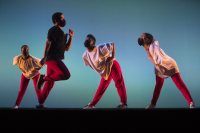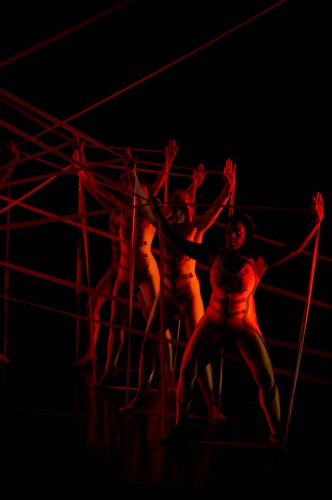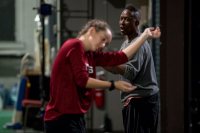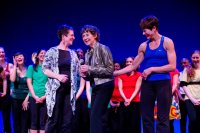
From hip hop to videodance to 1953 classic, dancers leap across genres

Students rehearse Alwin Nikolais’ “Tensile Involvement” in October. Photograph by Michael Bradley/Bates College.
Bates’ Fall Dance Concert brings together a wide range of styles, representing choreographers from across the country and here in Maine, in performances at 5 p.m. Saturday, Nov. 10; 2 p.m. Sunday, Nov. 11; and 7:30 p.m. Monday, Nov. 12.
The performances take place in Schaeffer Theatre, 305 College St. Admission is $6 for the general public and $3 for students and seniors, available at batestickets.com. For more information, please call 207-786-6161 (box office) or 207-786-8294.
On the program for the three performances:
- New hip hop and modern choreography by guest artists Robin Sanders of San Antonio, Texas, and Tiffany Rhynard of Gainesville, Fla.;
- The 1953 piece “Tensile Involvement” by modern-dance master Alwin Nikolais;
- Students in Debi Irons’ advanced Jazz Repertory class;
- A videodance and a solo by Assistant Professor of Dance Rachel Boggia.
Robin Sanders’ “Rhythm-n-Roots” highlights the history of hip hop dance, which is often omitted from history books. At Bates this fall, Sanders taught student dancers such classic hip-hop techniques such as popping and tutting. The roots of hip-hop reach into traditional West African dances, which make an appearance in the blood-pumping finale.
“Subverting Normal: Ensemble #2” by Rhynard uses movement and spoken language to examine the complexities of social behavior. The piece “challenges our assumptions and expectations of normalcy,” says the choreographer.
“Drawing from personal reflections on identity, the dancers demonstrate similarities and differences that ultimately connect them as human beings.” The piece is athletic, incorporating swing-era partnering among other genres.
“Tensile Involvement” is a feast for the senses, structured around elastic bands that criss-cross the stage and extend the dancers’ sharp and sinewy movements to the rafters. Combined with Nikolais’ original score and rich lighting, reconstructed by Michael Reidy of the Bates faculty, the piece creates a world that feels fresh and exciting despite its 50-plus years of age.
The piece was taught to Bates students by Alberto del Saz, artistic director for the Nikolais-Louis Foundation for Dance. Dance reconstructions at colleges form an important link in the chain that preserves ephemeral historical dance works, del Saz says.
Maine choreographer Irons presents jazz as a melting pot, with influences ranging from the Caribbean to Eastern Europe.
Boggia’s new solo “Shadow Game,” is really a duet: Her father, Chris Boggia, is shown training a horse in video projections that figure heavily in the piece.
Boggia also collaborated with students to make a videodance in the Bates squash courts.
“Choreographing for the camera in a nontraditional space is very different from choreographing for the stage,” says Boggia. “It allows me to play with time and space in ways that are impossible in live performance.”
The students featured in the videodance also shot much of the footage.
Student performers from many backgrounds and with diverse levels of experience worked with the guest artists. “The students rehearse 15 hours per week. While challenging, it’s a memorable learning experience to work through so many different perspectives in such a short period of time,” says Carol Dilley, director of the Bates dance program.




